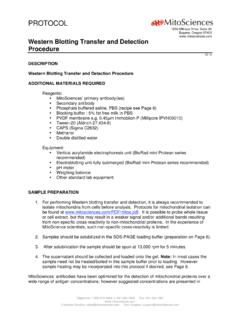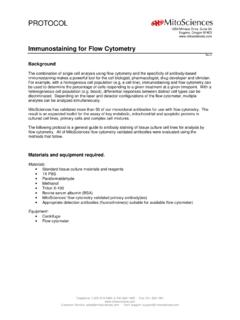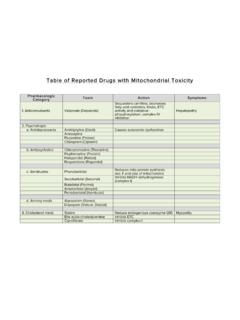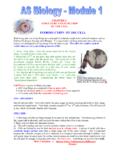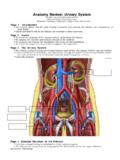Transcription of Benchtop Mitochondria Isolation Protocol - MitoSciences
1 December 2006 Benchtop Mitochondria Isolation Protocol Note: Specific protocols are available for the following products: MS850 Mitochondria Isolation Kit for Rodent Tissue MS851 Mitochondria Isolation Kit for Rodent Tissue (with Dounce Homogenizer) MS852 Mitochondria Isolation Kit for Cultured Cells MS853 Mitochondria Isolation Kit for Rodent Tissue (with Dounce Homogenizer) 2 CONTENT I. PRINCIPLES OF Mitochondria Isolation 3 II. REQUIRED REAGENTS AND EQUIPMENT 4 III. Mitochondria Isolation PROCEDURE 5 IV. MITOCHONDRIAL QUALITY ANALYSES 6 V. OPTIMIZATION STEPS AND GENERAL TIPS 8 VI. FLOW CHART 9 3I. PRINCIPLES OF Mitochondria Isolation MitoSciences s Benchtop Mitochondria Isolation kit allows for quick and efficient Isolation of intact Mitochondria from both soft and hard rodent tissues using differential centrifugation. Sufficient reagents are provided in the kit for 10 isolations, each requiring approximately an hour.
2 The key steps when isolating Mitochondria from any tissue or cell are always the same: (i) rupturing of cells by mechanical and/or chemical means, (ii) differential centrifugation at low speed to remove debris and extremely large cellular organelles (SPIN 1), and (iii) centrifugation at a higher speed to isolate and collect Mitochondria (SPIN 2). This crude mitochondrial preparation is often enough for most applications. The procedure detailed in this manual has been designed to provide the highest possible yield of intact and enzymatically active Mitochondria . Suggested amounts of starting material, expected Mitochondria yields, and Dounce strokes are shown in Table 1. Table 1. Sample Starting Material (wet weight) Expected Yield Dounce Strokes Rodent liver g 2 4 mg 20-35 Rodent heart* g 1 2 mg 30-40 Rodent brain g 4 5 mg 20-35 *Hard tissues result in lower yields due to difficult homogenization.
3 4II. REQUIRED REAGENTS AND EQUIPMENT Reagents Provided: 30 ml of Wash Buffer, store at 4oC 100 ml of Isolation Buffer, store at 4oC Reagents Needed: Double distilled water Protease inhibitor cocktail (PI), (Sigma, P8340) BCA Protein Assay (Pierce, 23225) Equipment Needed: ml Dounce Homogenizer with pestles ml Eppendorf tubes Scalpel pH meter, weighing balance and other standard lab equipment High speed Benchtop centrifuge 5 III. Mitochondria Isolation PROCEDURE As previously stated, the Mitochondria preparation follows three simple steps: cell rupturing, centrifugation to remove large particles and centrifugation to isolate Mitochondria . Below are guidelines for the preparation of Mitochondria from rodent liver, brain and heart. Buffers and samples should be chilled where possible. Weigh out appropriate amount of tissue and wash twice with ml of Wash Buffer (provided) Mince the tissue and place in pre-chilled Dounce homogenizer.
4 Add up to ml of Isolation Buffer (provided) 1. RUPTURE: To rupture the cells, perform number of Dounce strokes suggested in Table 1. Use pestle A (large clearance) for the initial strokes, then use pestle B (small clearance) for the remaining strokes. 2. SPIN 1: Transfer homogenate into a ml Eppendorf tube. If 300 mg or more of starting tissue was used, split the homogenate equally into two, ml Eppendorf tubes and fill each to ml with Isolation Buffer. Centrifuge the homogenate at 1,000g for 10 min, 4oC. Save the supernatant and discard the pellet. 3. SPIN 2: Transfer the supernatant into two new tubes and fill each to ml with Isolation Buffer. Centrifuge the supernatant at 12,000g for 15 min at 4oC. Collect the pellet (supernatant can be saved for quality analysis (Section IV)). 4. Wash each pellet by resuspending in ml of Isolation Buffer supplemented with 10 l protease inhibitor cocktail (stock = 100x).
5 Centrifuge at 12,000 g for 15 min at 4oC. 5. Collect the pellets and repeat this wash step. 6. Finally, combine pellets and resuspend in 500 l of Isolation Buffer supplemented with protease inhibitor cocktail. Freeze the aliquots at -80oC until use. If desired, mitochondrial quality assays described in section IV can be performed. 6IV. MITOCHONDRIAL QUALITY ANALYSES There are several MitoSciences products that can be used to test mitochondrial quality. Figure 1 demonstrates a typical western blot using isolated rat liver Mitochondria versus liver homogenate at 2 g and 10 g. Samples were probed with MitoSciences s Rodent Total OXPHOS Complexes Detection cocktail, MS604. Figure 1. Isolated Mitochondria show enriched signal when compared to the crude homogenate. In lanes 1 and 2, Rat liver Mitochondria isolated with MitoSciences s Benchtop Isolation Kit were loaded at 2 g and 10 g.
6 In lanes 3 and 4, rat liver homogenate was loaded at 2 g and 10 g, respectively. MW 1 2 3 4 50 37 25 20 15 Complex V Core 2 COXI Complex II 30 kDa Complex I 20 kDa 7 Mitochondria integrity can also be tested by screening for cytochrome c, porin, or cyclophilin D in the isolated Mitochondria versus in the supernatant fraction using MitoSciences antibodies MSA06, MSA03 and MSA04. Figure 2 depicts rat heart Mitochondria and supernatant screened with these antibodies. Figure 2. Rat heart Mitochondria were isolated from freshly extracted organs. The supernatant fraction was saved after SPIN 2 (Section III). 5 g of rat heart Mitochondria and 5 g of supernatant were loaded onto each lane and detected using MSA06 (cytC), MSA04 (Cyclophilin D), and MSA03 (Porin). Western blots show that minimal loss of cytochrome c, cyclophilin D and porin occurs during Mitochondria Isolation . In addition to MitoSciences s western blotting kits, Mitochondria activity can be measured using MitoSciences s MitoProfile Assay Kit for Complex IV activity (MS424 and MS427).
7 See for more details. 8V. OPTIMIZATION STEPS AND GENERAL TIPS Problem Probable Cause Solution Small mitochondrial pellet Insufficient lysis occurred Increase Dounce strokes Large amount of Cytochrome c in the cytosol Cells over-lysed/ Tissues not fresh Reduce Dounce strokes/Isolate from freshly extracted tissues BCA protein assay (Pierce) Mitochondria protein concentration is determined with the BCA Protein Assay kit (Pierce 23225), using bovine serum albumin as a standard according to the manufacturer s instructions. 9VI. FLOW CHART This guide is for quick reference only. Be completely familiar with the previous details of this document before performing the assay. Washed and minced tissue is suspended in Isolation Buffer DISRUPT CELLS Homogenize with Dounce Homogenizer following guidelines in Table 1 SPIN 1: 1,000 g for 10 min at 4oC, collect and save supernatant SPIN 2: 12,000 g for 15 min at 4oC, collect and save pellet Wash the pellet by resuspending in Isolation Buffer and protease inhibitor (PI), Centrifuge at 12,000 g for 15 min, collect pellet, repeat Resuspend the pellet in Isolation Buffer and PI, aliquot and freeze at -80oC Assay Mitochondria : protein concentration, western blot, OXPHOS activities 10 Phone: 1 800 910-6486 Fax: (541) 284-1801


